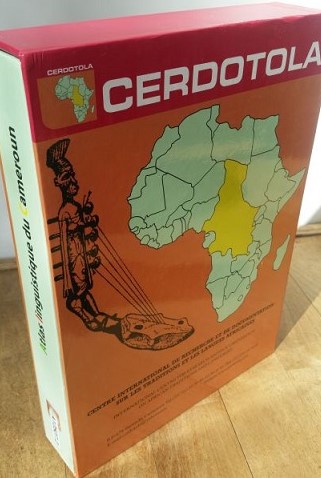New from CERDOTOLA, Cameroon: On languages and identity
 Every now and then, a librarian has an especially joyful moment. For instance, the moment when, years after Volume 1 of a particular book was obtained and put on the shelves, having given up on ever finding the second volume, it lands on your desk.
Every now and then, a librarian has an especially joyful moment. For instance, the moment when, years after Volume 1 of a particular book was obtained and put on the shelves, having given up on ever finding the second volume, it lands on your desk.
The now available complete Atlas linguistique du Cameroun, vols 1 & 2 is the result of a vast project of inventorying the ca. 250 African national languages of Cameroon. First edited in 1983, this is a revised and updated edition. The first part of Volume 1 contains an identification of the languages, while the second part aims at a classification of them.
The newly received Volume 2 is a bibliography on Cameroonian languages that includes references to works of different disciplines (anthropology, botany, zoology, geography, history), in so far as they contain lexical or other information on one or more Cameroonian languages. It also contains numerous references to unpublished theses and dissertations that testify to the vitality of the linguistic research undertaken at Cameroonian universities.
CERDOTOLA
This is just one of a number of books that we recently acquired from CERDOTOLA (Centre international de recherche et de documentation sur les traditions et les langues africaines / International Centre for research and documentation on African traditions and languages), based in Yaoundé, Cameroon. Established in 1977, following an initiative by a number of central African countries, supported by UNESCO, CERDOTOLA is an intergovernmental institution that works for sub-regional cooperation in the field of culture and in human and social sciences applied to the knowledge, protection, safeguarding and enhancement of the history, languages and cultural heritage of Africa. It is also a publisher. Its member States are: Angola; Burundi; Cameroon; Central African Republic; Chad; Congo; Democratic Republic of Congo; Equatorial Guinea; Gabon; Rwanda; and Sao Tome and Principe.
Afican Languages
The elaboration of linguistic atlases of the countries in the region is part of one of the scientific programmes of CERDOTOLA, which aims to establish the position of African languages and to confirm their role as living, actual languages of communication and to service their development.
The books edited by CERDOTOLA reached us just before the corona crisis hit Europe and Africa, while Cameroon was already suffering from ‘the Anglophone crisis’, and therefore already familiar with lockdown measures in the two Anglophone regions of Cameroon, due to extensive fighting between separatist movements.
The Grassfields
 In the collective work Les Grassfields du Cameroun, des fondements culturels au développement humain/The Grassfields of Cameroon, from culture to human development, researchers from different disciplines (archaeology, history, linguistics, sociology, anthropology, geography) try to resolve the ‘Grassfields enigma’, and examine the construction of the identity or maybe the identities of this region, characterized by, among others, linguistic diversity and, as a result of colonial history, by a population that defines its identity in part based on their adopted language, which is either English or French (the region is divided between Anglophones and Francophones).
In the collective work Les Grassfields du Cameroun, des fondements culturels au développement humain/The Grassfields of Cameroon, from culture to human development, researchers from different disciplines (archaeology, history, linguistics, sociology, anthropology, geography) try to resolve the ‘Grassfields enigma’, and examine the construction of the identity or maybe the identities of this region, characterized by, among others, linguistic diversity and, as a result of colonial history, by a population that defines its identity in part based on their adopted language, which is either English or French (the region is divided between Anglophones and Francophones).
These are just two examples of the newly acquired items from CERDOTOLA. They encompass a broad range of subjects, from archaeology, history and linguistics to economics and literature. We also received some booklets each containing a folktale, both in an African language and in French.
Elvire Eijkman




